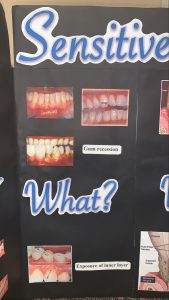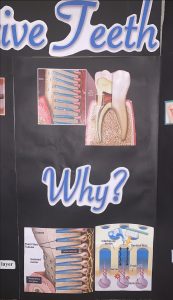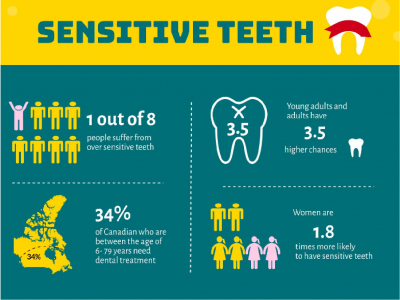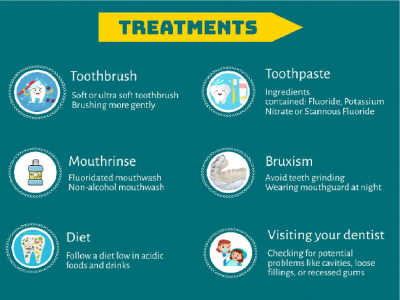



Sensitive teeth
The Journal of the American Dental Association shows that one out of every eight Americans suffers from teeth sensitivity—otherwise known as dentinal hypersensitivity—but few of us talk to a dentist about it. Adults between 18-44 years have 3.5 higher chances of having sensitive teeth. Women are 1.8 times more likely to have sensitive teeth than men
The Stage of oral health in Canada states that 34% of Canadians who are between 6-79 years need dental treatment.
It happens to everyone when you least expect it; a quick swig of hot chocolate after coming in from the cold and ouch! Your teeth react to the temperature change as if you had been chewing on tin foil. If hot, cold, sweet or very acidic foods and drinks, or breathing in cold air, makes your teeth or a tooth sensitive or painful then you have sensitive teeth. Tooth sensitivity is a common name for dentin hypersensitivity.
What causes tooth sensitivity?
The phrase “tooth sensitivity” refers to tooth discomfort or feelings of toothache in one or more teeth. The pain of tooth sensitivity is usually sharp, sudden and shooting. Tooth sensitivity occurs when the layer of a tooth underneath the enamel (called the dentin) or the layer covering the root (called cementum) is exposed along the gum line due to receding gums. The exposed areas respond to hot and cold, and sometimes too sweet and spicy foods, and trigger pain. Some people may experience tooth sensitivity from brushing or flossing their teeth.
Some factors which can contribute to tooth sensitivity include:
- Overzealous brushing: You can have too much of a good thing. Brushing your teeth with too much force, or with a hard-bristle toothbrush, may wear down tooth enamel, expose the cementum or dentin and cause tooth sensitivity.
- Tooth grinding: Grinding your teeth can cause the enamel to wear away and leave the dentin exposed.
- Dental cleanings or treatments.
- Temporary tooth sensitivity: which can occur after a professional teeth-whitening treatment, but usually goes away shortly after the procedure ends.
- Gum disease: Inflamed gum tissue pulls away from the tooth, leaving vulnerable areas exposed.
- Erosion of tooth surfaces due to excessive acid in the diet
- Dental caries
Characteristic of pain from hypersensitivity:
- Sharp, short, or transient pain with rapid onset
- Cessation of pain upon removal of stimulus
- Presents as a chronic condition with acute episodes
- Pain in response to a non-noxious stimulus, one that would not normally cause pain or discomfort
- The discomfort that cannot be ascribed to any other dental defect or pathology.
Why does dentin exposed make teeth sensitive?
- Is due to the abrupt movement of fluid within the dentinal tubules in response to cold and heat (thermal), osmotic (e.g. eating sugary foods), mechanical (e.g. chewing) and evaporative stimuli (e.g. air blasts).
- Transient pain arising from exposed dentin, typically in response to a stimulus, which cannot be explained as arising from any other form of dental defect or pathology and subsides quickly when the stimulus is removed.
- Dentine sensitivity is a sign of acid erosion and normally occurs in patients with meticulous oral hygiene.
Hydrodynamic theory:
- muli initiate the flow of lymphatic fluid in dentinal tubules, odontoblasts and their processes transmit the sensory stimuli.
- Movement of the fluid causes nerve endings at the pulpal wall to be stimulated and produce pain.
- Stimuli: Temp (usually cold), sugar and acidic foods are often the culprits
- Currently accepted mechanism for pain impulse transmission to the pulp as a result of fluid movement within the dentinal tubule, which stimulates the nerve endings at the dentino pulpal interface.
How is tooth sensitivity treated?
There are several ways to treat sensitive teeth.
- If tooth sensitivity is mild, over the counter dental treatments are a good choice.
- Keep the teeth clean (free of food debris).
- Use a fluoridated mouthwash daily.
- Selecting a soft or ultra-soft toothbrush is a good choice for sensitive teeth.
- Also, when we brush one or two teeth at a time gently.
- Select the toothpaste for Sensitive Teeth. Fluoridated toothpaste, not tartar-control toothpaste. While most toothpaste has similar basic ingredients, some contain an extra active ingredient to treat specific problems such as sensitive teeth. Here are two ingredients to look for:
- Potassium Nitrate: Prevents the nerve from passing the pain signal across the synapses. Numbs the nerve so you do not feel pain, hot and cold, so the potassium nitrate is known as a “nerve-calming” ingredient.
- Stannous Fluoride: reacts with your tooth enamel to produce a repairing layer over the vulnerable areas of your teeth. This protective layer helps shield against short sharp sensations caused by sensitivity. Blocks tubule holes.
The sensitive toothpaste contains both or one of the above. Choose a toothpaste that’s labeled as being specifically made for sensitive teeth. These toothpaste won’t have any irritating ingredients and may have desensitizing ingredients that help block the discomfort (tubule holes) from traveling to the nerve of the tooth.
- If home treatments don’t work, you can talk to your dentist about prescription toothpaste and mouthwash. They may also apply a fluoride gel or prescription-grade desensitizing agents in-office. These can help to strengthen the enamel and protect your teeth.


https://www.healthline.com/health/sensitive-teeth#2 https://oralb.com/en-us/oral-health/conditions/teeth-sensitivity/sensitive-teeth-causes-treatments-prevention https://www.pinterest.com/pin/27584616439166355/ Intraoral preventive procedures and practicum Textbook

